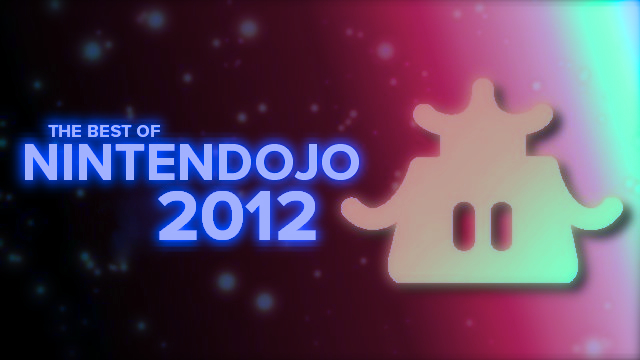|
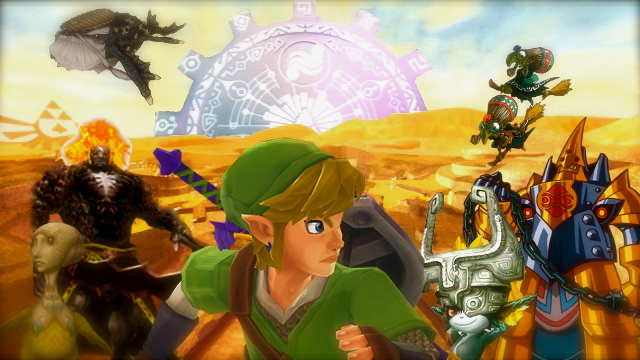
The timeline of The Legend of Zelda series has been something of an obsession for many years now. Entire websites have been dedicated to research into this field, and innumerable flame wars have resulted. Such a delicate matter is this topic, that it seemed even Nintendo didn’t want to touch it with a Deku Stick.
Until the release of the official Zelda timeline in December’s Hyrule Historia book, that is. Released to celebrate The Legend of Zelda series’ 25th Anniversary, it contained the official timeline. Prior to this, us fanboys had only received snippets of which game went where. We knew that Ocarina of Time led into Majora’s Mask, and that The Wind Waker happened some time after — but the rest was merely conjecture. Things became cloudy, though, when Eiji Aonuma, series Co-Director, hinted vaguely that Ocarina of Time had two endings — an Adult Ending (not THAT kind) and a Child Ending. This led to speculation that the timeline split in two after Link travelled back in time at the end of Ocarina of Time.
This theory was confirmed when Twilight Princess showed us a Hyrule where Ganondorf never managed to kidnap Princess Zelda (thanks to Link’s warning from the future), and was instead sentenced to death…except they couldn’t kill him because he had the Triforce of Power, so the sages instead used the Mirror of Twilight to send him to the Twilight Realm.
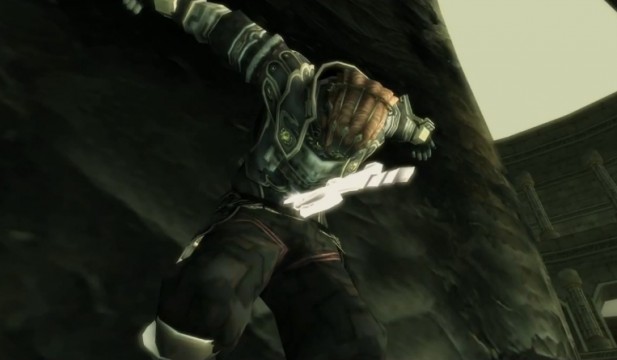
Why he waited until he was stabbed in the chest to escape, I will never know.
This was inconsistent with The Wind Waker, in which we are told that Ganondorf was defeated, and the Hero of Time disappeared, meaning noone could stop Ganondorf’s return…so King Daphnes decided to flood Hyrule and promptly turned into a boat.
So, here we have two distinct branches: one where Adult Link defeats Ganondorf, who comes back and is then trapped under the Great Sea (and then comes back), and one where Child Link warns Zelda, and Ganondorf is sent to the Twilight Realm (and then comes back). Simple, yes? So far.
Skyward Sword was announced to be chronologically first in the series. Link resides in Skyloft, created by the heretofore unseen Goddess, Hylia, who sealed away a great evil in the land below the clouds (Hyrule), and hid the Triforce in a giant statue of herself on Skyloft. This great evil turns out to be an entity called Demise, who upon his defeat swears that in generations to come, his influence will haunt Link’s descendants (as Ganondorf, obvs).
With Nintendo’s official word though, it’s become apparent that there are in fact three branches in the timeline. The aforementioned two, and one where Link failed to defeat Ganondorf at the end of Ocarina of Time. Well, this is what happens when you mess with time, it goes haywire.
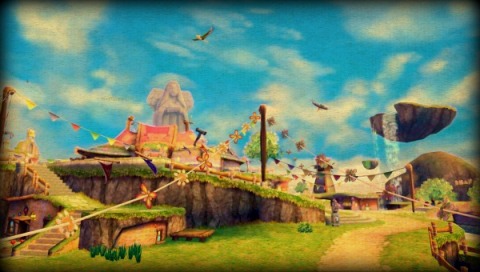
Hylia’s completely inconspicuous hiding place for the Power of the Gods. I wonder where it could be…
Some of the placings on the timeline have me confused, though; they do not make sense. A Link to the Past tells us that Ganon emerges with a horde of dark beings from the Dark World, which is accessible from Hyrule through a mirror. Apparently, though, these are not the Twili, nor the Twilight Realm, nor the Mirror of Twilight… Why not?! It’d make perfect sense and yet it’s now become unnecessarily convoluted; A Link to the Past and Twilight Princess aren’t even in the same branch for Din’s sake!
I also have issues with Skyward Sword. The Temple of Time was in the Lanayru area, but was destroyed, and a replacement was eventually built in the Sacred Grounds. Fair enough. The destroyed Lanayru Temple, though, was strikingly similar to the Gerudo area in Ocarina of Time (minus the Desert Colossus), so they could be the same place, because at the end of Skyward Sword, the Statue of Hylia descends down to the Temple of Time to seal Demise… in the Sacred Grounds!? It would have made far more sense to have the statue descend to Lanayru, where with time it would become the Desert Colossus – they even look similar.
Plus, in Ocarina of Time, Twinrova raised Ganondorf in the Gerudo area. Wouldn’t it have made more sense story-wise for Demise to be sealed away in a remote location devoid of civilisation rather than in a forest inhabited by helpless plant-birds? Say, a desert? Twinrova could’ve revived Demise in Gerudo form using magic, seeing as there was a male due to be born, as Demise would’ve been conveniently sealed away right there. Nintendo missed a trick there. They also changed the location of the Temple of Time completely, come Ocarina of Time. Arguably, it could be a new one, but the location of the Temple of Time in Twilight Princess does correspond with that of Skyward Sword.
Skyward Sword also messed with the Goddesses. Traditionally, Nayru is represented by blue, and water; Din by red, and fire; Farore by green, and forest. The newest game, though, had these Goddesses embodied in the form of dragons, and their names were altered slightly (as with the provinces in Twilight Princess). For some reason, Skyward Sword had Faron as a forest area, yet guarded over by the Zora-like blue water dragon, and Lanayru was a yellow thunder dragon. It would not have hurt to have a water area separate from Faron Woods, thereby not messing with the system, but alas and alack, Nintendo seems determined to drive me mad.
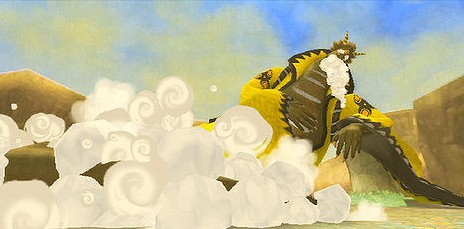
The offending dragon. That ‘dust cloud’ could be considered offensive too…
A nice touch that Skyward Sword added, however, was the implication that Groose — with his red hair, tanned skin, and golden eyes and lips — flew off in the direction of the Lanayru Desert, instead of going back to Skyloft. Perhaps to start the Gerudo race? Worryingly, though, there were no females that went with him…
Other inconsistencies and mysteries include: Levias, giant sky fish who commands the winds… yet isn’t the Wind Fish from Link’s Awakening; Onox from Oracle of Seasons, Iron Knuckle from Ocarina of Time, and Zant from Twilight Princess — why do they all look so similar?; are the Oocca descended from the people of Skyloft in some way? Skyloft’s inhabitants are all named after birds (even Hylia), after all.
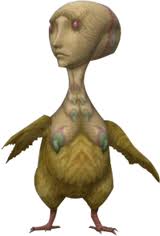
The dreaded Ooccoo, and her terrifying, horrifying, Darwin-defying breasts.
Sadly, it seems to me that despite being, in my opinion, the best game in the franchise, Skyward Sword and Nintendo’s timeline raised more questions than they answered. Ganondorf’s origins were, despite geographically confusing, dealt with well, but as for other timeline related aspects…well, to quote a certain other time traveller: “People assume that time is a strict progression of cause to effect, but actually from a non-linear, non-subjective viewpoint — it’s more like a big ball of wibbly wobbly…timey wimey…stuff”. Maybe Nintendo should have taken that approach.




 ShareThis
ShareThis